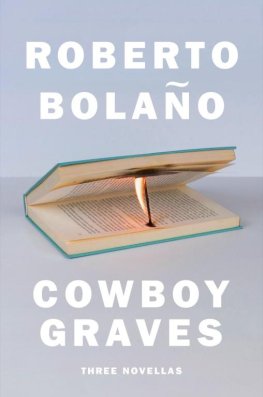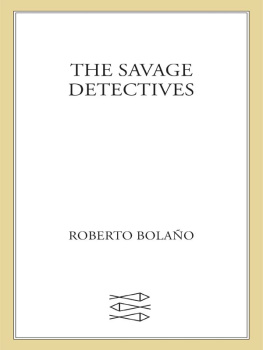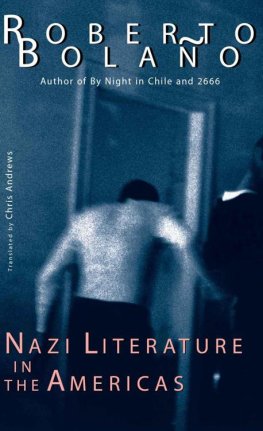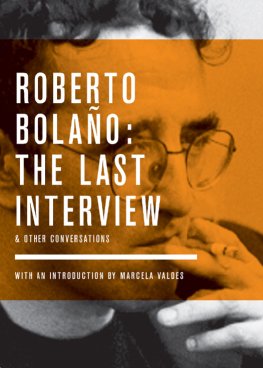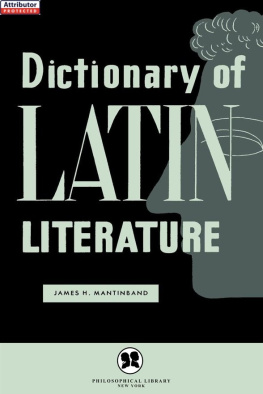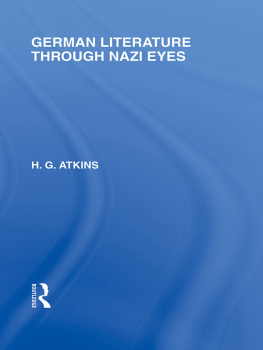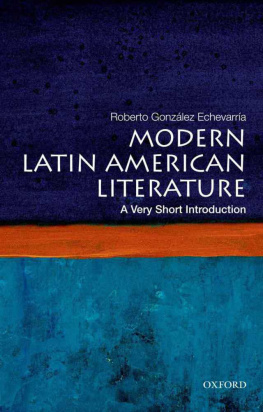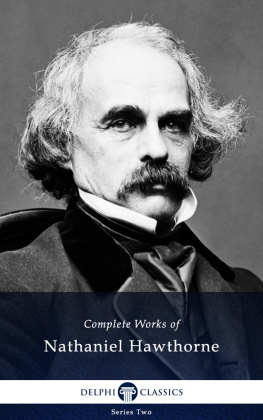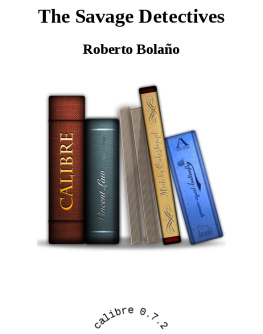Roberto Bolao
Nazi Literature in the Americas
Translated by CHRIS ANDREWS
A NEW DIRECTIONS BOOK
for Carolina Lpez
Contents
If the flow is slow enough and you have a good bicycle, or a horse, it is possible to bathe twice (or even three times, should your personal hygiene so require) in the same river.
Augusto Monterroso
THE MENDILUCE CLAN
EDELMIRA THOMPSON DEMENDILUCE
Buenos Aires, 1894Buenos Aires, 1993
A t fifteen, EdelmiraThompson published her first book, To Daddy, which earned her a modestplace in the vast gallery of lady poets active in Buenos Aires high society. Andfrom then on, she was a regular presence in the salons of Ximena San Diego andSusana Lezcano Lafinur, dictators of taste in poetry, and of taste in general,on both banks of the Ro de la Plata at the dawn of the twentieth century. Herfirst poems, as one might reasonably have guessed, were concerned with filialpiety, religious meditation and gardens. She flirted with the idea of taking theveil. She learned to ride.
In 1917 she met the rancher and entrepreneur Sebastian Mendiluce,twenty years her senior. Everyone was surprised when they announced theirengagement, after only a few months. According to people who knew him at thetime, Mendiluce thought little of literature in general and poetry inparticular, had no artistic sensibility (although he did occasionally go to theopera), and his conversation was on a par with that of his farmhands and factoryworkers. He was tall and energetic, but not handsome by any means. There was,however, no disputing his inexhaustible wealth.
Edelmira Thompsons friends considered it a marriage of convenience,but in fact she married for love. A love that neither she nor Mendiluce was everable to explain and which endured imperturbably all the days of her life.
Marriage, which ends the careers of so many promising women writers,quickened the pen of Edelmira Thompson. She established a salon in Buenos Airesto rival those of the redoubtable Ximena San Diego and Susana Lezcano Lafinur.She took young Argentinean painters under her wing, not only buying their work(in 1950 her collection of paintings and sculptures was, if not the best in theRepublic, certainly one of the largest and most extravagant), but also invitingthem to paint at her ranch in Azul, far from the madding crowd, all expensespaid. She founded a publishing house, The Lamp of the South, which brought outmore than fifty books of poetry, many of which were dedicated to Edelmiraherself, the fairy godmother of Argentinean letters.
In 1921 she published her first book of prose, All My Life,an idyllic and rather flat autobiography, devoid of gossip, full of landscapesand poetic meditations. Contrary to the authors expectations, it disappearedfrom the bookshop windows in Buenos Aires without leaving so much as a ripple.Disappointed, Edelmira set off for Europe with her two small sons, two servants,and more than twenty suitcases.
She visited Lourdes and the great cathedrals. She had an audience withthe Pope. A yacht took her from island to island in the Aegean. She reachedCrete one midday in spring. In 1922, in Paris, she published a book ofchildrens verse in French, and another in Spanish. Then she returned toArgentina.
But things had changed, and Edelmira did not feel at ease in hercountry. Her new book of poems (European Hours, 1923) was described ina local newspaper as precious. The nations most influential reviewer, Dr.Enrique Belmar, described her as an idle, childish lady whose time and energywould be better spent on good works, such as educating all the ragged littlerascals on the loose throughout this vast land of ours. Edelmiras elegantreply consisted of an invitation to attend her salon, addressed to Belmar andother critics, which was ignored by all but four half-starved gossip columnistsand crime reporters. Humiliated, she retired to her ranch in Azul, accompaniedby a faithful few. Soothed by the rural calm and the conversations of simple,hardworking country folk, she set to work on the new book of poetry that was tobe her vindication. Argentinean Hours (1925) sparked scandal andcontroversy from the day of its publication. In her new poems, Edelmirarenounced contemplative vision in favor of pugnacious action. She attackedArgentinas critics and literary ladies, the decadence besetting the nationscultural life. She argued for a return to origins: agrarian labor and thestill-wild southern frontier. Flirting and swooning were behind her now.Edelmira longed for the epic and its proportions, a literature unafraid to facethe challenge of singing the fatherland. One way and another, the book was agreat success, but, demonstrating her humility, Edelmira barely took the time torelish her triumph, and soon left for Europe once again. She was accompanied byher children, her servants, and the Buenos Aires philosopher Aldo Carozzone, whoacted as her personal secretary.
She spent the year 1926 traveling in Italy with her numerousentourage. In 1927, she was joined by Mendiluce. In 1928, her first daughter,Luz, a bouncing, ten-pound baby, was born in Berlin. The German philosopherHaushofer was godfather to the child, and the baptism, attended by the cream ofthe German and Argentinean intelligentsia, was followed by three days ofnon-stop festivities, which culminated in a little wood near Rathenow, where theMendiluces treated Haushofer to a kettledrum solo composed and performed bymaestro Tito Vsquez, who went on to become a sensation.
In 1929, the stock-market crash obliged Sebastian Mendiluce to returnto Argentina. Meanwhile Edelmira and her children were presented to AdolfHitler, who held Luz and said, She certainly is a wonderful little girl.Photos were taken. The future Fhrer of the Reich made a great impression on theArgentinean poet. Before leaving, she presented him with several of her ownbooks and a deluxe edition of Martin Fierro. Hitler thanked her warmly,beseeching her to translate one of her poems into German on the spot, a taskwhich, with the help of Carozzone, she managed to accomplish. Hitler was clearlydelighted. The lines were resounding and looked to the future. In high spirits,Edelmira asked for the Fhrers advice: which would be the most appropriateschool for her sons? He recommended a Swiss boarding school, but added that thebest school was life itself. By the end of the audience, Edelmira and Carozzonewere committed Hitlerites.
1930 was a year of voyages and adventures. Accompanied by Carozzone,her young daughter (the boys were boarding at an exclusive school in Berne) andher two Indian servants, Edelmira traveled up and down the Nile, visitedJerusalem (where she had a mystical experience or a nervous breakdown, whichconfined her to a hotel bed for three days), then Damascus, Baghdad...
Her head was buzzing with projects: she planned to launch a newpublishing house back in Buenos Aires, which would specialize in translations ofEuropean thinkers and novelists; she dreamed of studying architecture anddesigning grandiose schools to be built in parts of the country as yet untouchedby civilization; she wanted to set up a foundation in memory of her mother, withthe mission of helping young women from poor backgrounds to fulfill theirartistic aspirations. And little by little a new book began to take shape in hermind.
In 1931 she returned to the Argentinean capital and began to carry outher projects. She launched a magazine, Modern Argentina, edited byCarozzone, whose mission was to publish the latest in poetry and fiction, butalso political commentary, philosophical essays, film reviews, and articles onsocial issues. Half of the first number was devoted to Edelmiras book TheNew Spring, which came out simultaneously. Part travel narrative, partphilosophical memoir, the book reflected on the state of the world, and thedestinies of Europe and America in particular, while warning of the threat thatCommunism posed to Christian civilization.
Next page


